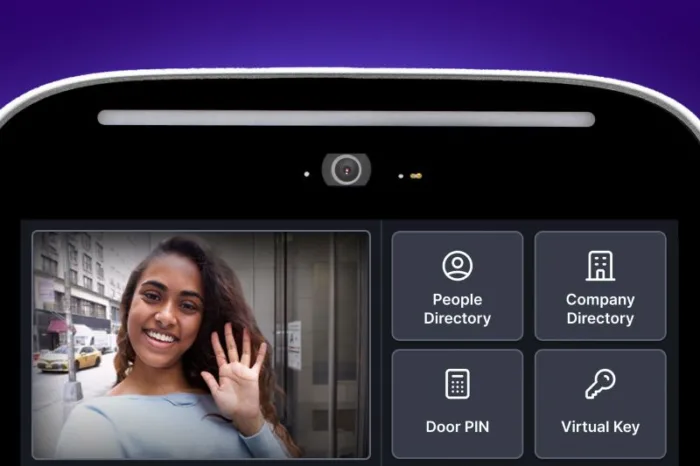Key takeaways:
- The best door entry systems are those that are wireless, support multiple credentials, and integrate seamlessly with other hardware and software your property uses.
- Video door access control systems improve building security by ensuring tenants can visually confirm who’s requesting access before letting them in.
- Wireless entry systems are easier and more affordable to install than wired ones.
- Door entry systems are commonly installed at apartments, condos, office buildings, student housing, and senior living facilities.
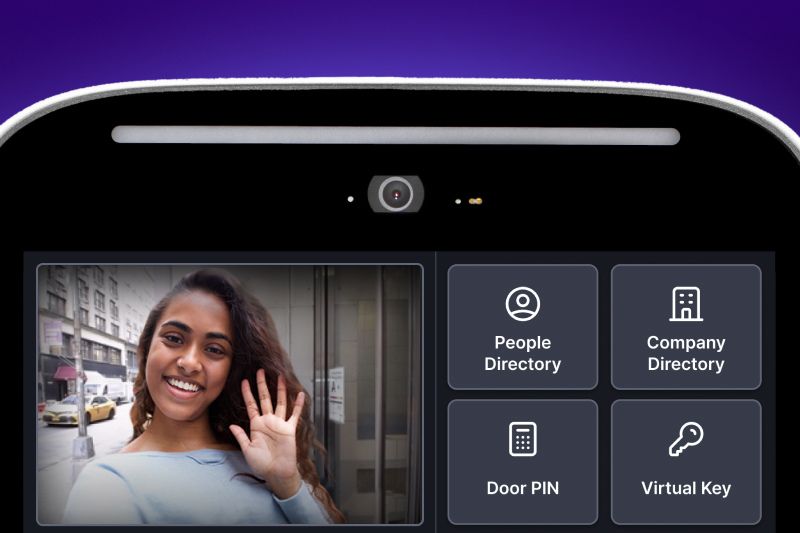
Every building needs a way to control access, regardless of the type. As a property owner, manager, or developer, you need to make sure your building has a reliable way to get tenants, guests, and delivery carriers through the front door. In other words, you need a door entry system.
In this complete guide to entry systems, we explore the four main types of property access solutions you can choose from. Then, we explain which features to look for in the best entry system. Most importantly, we give you a list of the best door entry systems on the market.
This guide covers:
- 5 best door entry systems
- How does a door entry system work?
- Types of door entry systems
- Where are door entry systems used?
- Considerations for door entry systems
5 best door entry systems
The five best door entry systems are:
1. ButterflyMX
Established in 2014, ButterflyMX has been installed in over 15,000 buildings and garnered over 40,000 five-star reviews.
By eliminating in-unit hardware and building wiring, the ButterflyMX Video Intercom is a cost-effective door entry system that empowers residents and employees to open doors from smartphones.
Meanwhile, property managers and owners can manage access permissions, review audit logs, and grant access remotely from the ButterflyMX OS or online dashboard. Our Video Intercom even integrates seamlessly with property management software to simplify tenant access management.
ButterflyMX Video Intercom features
Our flagship product, the Video Intercom, offers the following features:
- Top-rated mobile app. With the ButterflyMX mobile app, tenants can create and send Visitor Passes and one-time delivery passes to visitors for easy access.
- Cloud-based software. The ButterflyMX OS is powerful cloud-based software that lets property staff manage access, review entry logs, and update tenant information from anywhere.
- Sophisticated design. Merging style with functionality, the ButterflyMX door entry solution is elegant and easy to use.
- Multiple credentials. Choose between using a variety of credentials. The ButterflyMX Video Intercom supports mobile apps, key cards, fobs, and PIN codes. That way, you, your employees, and your tenants can use the most convenient credentials.
- Wide-angle camera. The wide-angle 156° camera lens offers unmatched clarity for all entry events. So, you never miss a moment.
- 8” and 12” displays. These LED screens are available in 8” or 12” and can be installed in surface or recessed mounts for optimal versatility, sure to suit your property’s unique needs.
- Robust hardware. The intercom is vandal-resistant and weatherproof, ensuring it’ll withstand all climates and environments.
- Integrations. Pair our Video Intercom with our other products for a seamless property-wide access solution. We also support a wide range of third-party integrations to centralize your property management experience.
2. LiftMaster
The LiftMaster CAPXS Smart Video Intercom S is a popular entry system that combines advanced technology with user-friendly features. It offers seamless smartphone integration, allowing residents to manage access remotely and communicate with visitors in real-time.
Some notable features include:
- Built-in 1080p night-vision camera with a 135° field of view
- 5” 720p touchscreen display
- Can store up to 1,000 video events locally
- Provides real-time data using the myQ community app
- Access door status, track resident information, and set up door schedules
3. Viking
The Viking AES-2000S is an accessible entry system that provides audio and visual assistance for users with disabilities. This surface-mount system offers robust features that enhance security and convenience for multi-tenant buildings. It even includes an EZ HELP button that instructs the user on how to use the system both on the display and audibly.
The Viking AES-2000S electronic door entry system offers:
- Supports up to 525 tenants’ names and phone numbers
- Built-in keypad for a keyless door entry system option
- Weather-resistant design with a vandal-resistant faceplate and housing
- 16-position backlit display with large characters for easy readability
- Has a TTY jack for connecting personal teletypewriters
4. Linear
The Linear AE-100 is a traditional, straightforward telephone entry system for single-door applications. It is ideal for small—to medium-sized properties that require basic access control functionality without complex features.
Speaking of features, you can expect the following from Linear’s telephone door entry system:
- Accepts up to 125 directory listings and stand-alone entry codes
- Available in surface-mounted, recessed, and gooseneck installation
- Two-line-16-character LCD display
- Includes a tamper-resistant speaker and a TTY connector for those who are hearing impaired
- Multilingual display that supports English, Spanish, French-Canadian, and Portuguese
5. DoorKing
The DoorKing 2108 eVolve Video Entry System is a cloud-based solution designed for properties with 10 or fewer tenants. This system combines video capabilities with mobile access control features to enhance security and resident convenience. It uses the eVolve Cloud, enabling mobile access from a desktop, tablet, or smartphone.
DoorKing’s video entry system includes the following features:
- Can control up to three entry points
- Operates with either an internet connection or VoIP (cellular connection)
- Designate up to four different phones to receive guest calls that ring simultaneously
- Supports up to 40 phone numbers and 25 entry codes
- Built-in IP camera to support two-way video calling
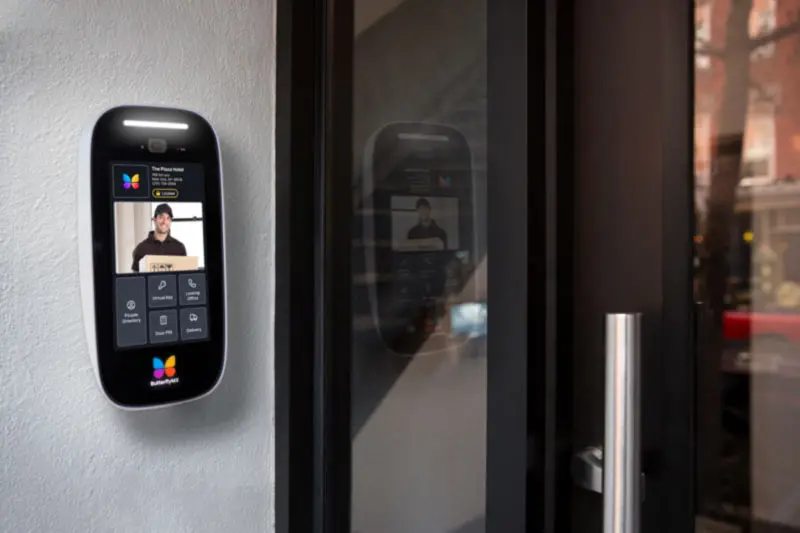
How does a door entry system work?
An entry system works by verifying the identities of authorized tenants and providing a way for visitors to request property access. All door entry systems need hardware installed at the entrance (often outdoors). This outdoor door entry system is called the base station. Some systems also require hardware installed in every unit throughout the building. Those devices are called substations.
Substations and base stations within a building entry system may communicate via wiring (if it’s a wired system) or the internet if it’s wireless. The best systems are IP door entry systems, which means they are internet-connected and communicate via the Internet Protocol.
To use a building entry system, a visitor searches for a resident in the system’s directory and presses a button to contact them. The system alerts the tenant that they have a visitor, usually through a phone call and mobile app notification. Then, the tenant speaks with their visitor and opens the door for them by pressing a button. When the tenant presses the ‘door release’ button, the system sends a signal to the door’s electric or magnetic lock, which allows entry.
Building tenants can also grant themselves access through entry systems. Tenants may use a keycard, a fob, or a mobile app on their smartphones to gain access through the building entry system.
Watch how ButterflyMX works:
Types of door entry systems
“Door entry system” is a broad term for a wide range of building access solutions.
There are four main types of door entry systems:
Access control systems
An access control system is any solution that enables authorized users to grant themselves property entry with a verified credential.
Access control systems are a kind of keyless entry system, which means tenants can enter a room or building without a physical key. By eliminating traditional locks and keys, building owners and operators save money and add unbeatable convenience to their properties.
However, these entry systems only enable access for tenants or authorized individuals. They don’t povide a way for guests to request access.
The two main types of access control systems for door entry:
RFID door entry systems
RFID — “radio-frequency identification” — is a technology that uses radio waves to scan data stored inside an RFID tag. Fob door entry systems and key card access control use RFID technology.
Fobs are small electronic devices with a built-in microchip. Users scan their fob at an RFID reader or press a button on the fob to open the door. Fob access is used across industries at all types of entryways. For businesses, commercial key fob door entry systems facilitate access for employees, who must carry their fob to and from the office. Apartment buildings also use fob systems, both outside and within the building. Residents can use fobs to enter the front door and areas like mailrooms, gyms, and other amenity spaces.
Key cards either use RFID, Wiegand, or magstripe technology. RFID key cards contain a built-in microchip. Users tap their key card on the card reader at the entrance to gain access.
Keypad door entry systems
In contrast to RFID systems, keypad door entry systems don’t require users to carry a physical device, like a card or fob. Instead, users enter a PIN code on the keypad.
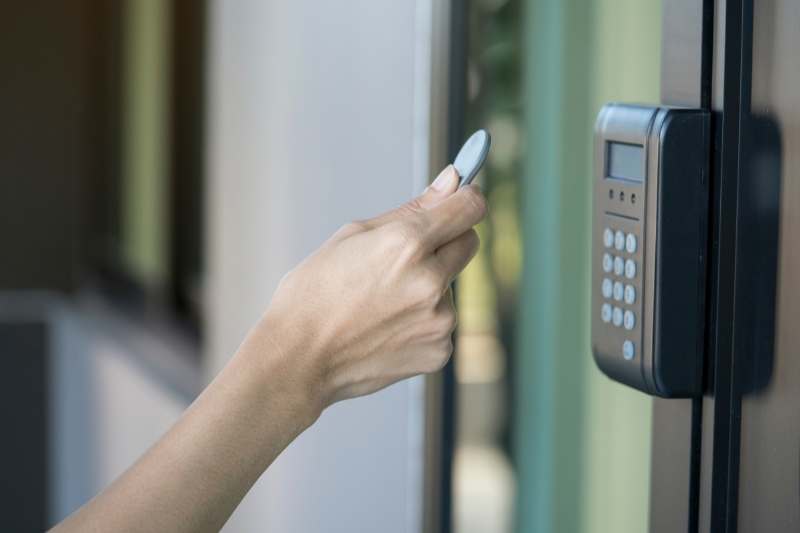
Buzzer systems
Apartment buzzer entry systems let visitors alert tenants that they need access to a building. They also let tenants talk to visitors and open the door for them remotely.
Buzzer systems have two components:
- Entryway hardware. This is the device installed at the front door or gate. It usually has a ‘call’ button for each unit in the building. Visitors use the hardware to select a tenant and call them.
- In-unit devices are pieces of hardware installed in every unit throughout the building. Most in-unit devices have three buttons: talk, listen, and door open. Renters use these devices to talk to visitors and open the door.
One significant downside to buzzer systems is that tenants can only speak to visitors through the in-unit device — they can’t use their cell phones.
Another downside is that buzzer entry systems require wiring to be run throughout the building. This wiring connects the hardware at the entrance to every in-unit device throughout the building, making installation extremely expensive and challenging.
Door phone entry systems
A door entry phone system enables visitors to talk to building tenants via telephone. It also lets a tenant open the door for visitors by pressing ‘9’ on their phone.
Door phone entry systems require:
- Hardware at the entryway with a tenant directory
- A telephone line or cellular service for phone calls
- Tenants’ telephones (landlines or cell phones)
Telephone entry systems are easy to use but outdated and sometimes unreliable. Most of these systems require staff to update the resident directory onsite — they can’t be programmed and updated remotely. And since they don’t have a camera, tenants can’t visually confirm who’s requesting access.
Here’s how a door entry phone works:
- First, visitors use the phone entry system hardware to find and select the tenant they’re visiting.
- Then, the system calls that tenant, who can answer it from their telephone.
- Finally, if the tenant wants to unlock the door for their visitor, they press ‘9.’
Intercom systems
Intercoms are the most robust and versatile building entry systems. They enable communication between visitors and tenants and offer various entry methods.
There are several kinds of intercom systems. An intercom can be wired or wireless. Similar to buzzer systems, intercoms can operate with in-unit hardware, but they may use residents’ cell phones instead.
The best intercom systems:
- Have a camera to enable video calling.
- Are cloud-based for remote management.
- It comes with a mobile app to open doors from your smartphone and manage access from anywhere.
- Offer several ways to open the door, such as Visitor Passes, delivery PINs, and voice commands.
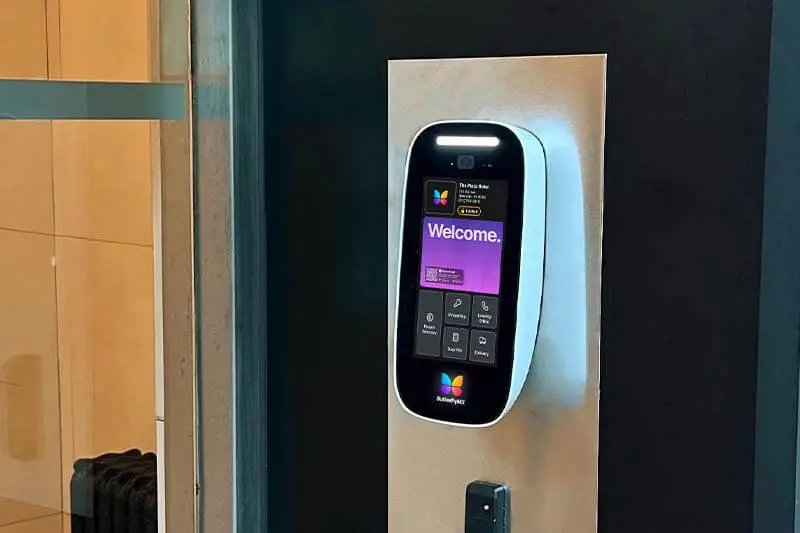
Where are door entry systems used?
An entry system can be installed in any kind of building. The right system for your building depends on its infrastructure and access needs.
Here is where you’ll typically find these access systems:
- Apartments and condos. Every apartment and condo needs a building entry system. Door entry systems for apartments and condos ensure visitors and delivery drivers can easily enter the building, providing greater convenience and security for residents.
- Businesses and offices. Commercial door entry systems are ideal for office buildings and other types of businesses. A door entry system for businesses makes it easy for tenants and employees to come and go without worrying about carrying keys or fobs. Office door entry systems are also great solutions for visitor management, as tenants can grant them access remotely using the respective mobile app.
- Gated communities. Entry systems can even be installed at gated entrances of both multifamily and commercial properties.
- Industrial buildings. Properties like self-storage facilities and warehouses also benefit from a door access control system to ensure that only authorized personnel can enter the building. In addition, members or employees of these facilities can grant guests remote access.
- Student housing. College students are bound to have a lot of guests and package deliveries, so a feature-rich door entry system that supports a mobile app is ideal. Such a system will attract student residents and improve their overall living experience.
- Senior living facilities. It’s critical to have a user-friendly and intuitive door entry system with an easy-to-use interface for seniors. This way, senior residents can grant access to loved ones when visiting.
Considerations for door entry systems
If you’re looking for the best entry system for your building, a few features should be on your checklist.
The best door entry systems offer these four features:
Video door entry systems
One of the most valuable features of an entry system is a camera. Door entry systems with a camera enable video calling, which means tenants can video chat with visitors instead of just an audio call. As a result, renters can see who’s at the door before opening it for anyone.
A video door entry system significantly improves security at your building. Residents can make sure they’re only letting known visitors into the building. And off-site property managers can visually confirm a prospect’s identity through a video call before granting them property access.
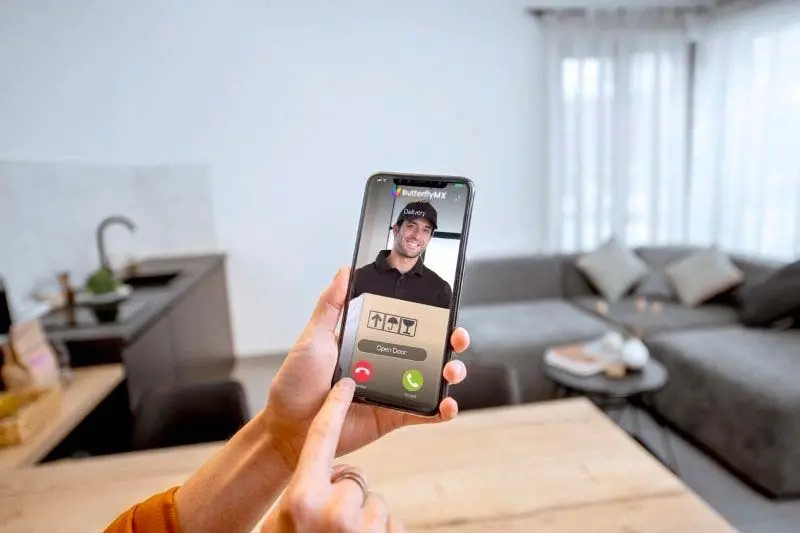
Wireless door entry systems
A wireless door entry system is equally valuable as a system with a camera. Wireless systems don’t need wiring between the entryway hardware and each in-unit device; instead, devices within the system communicate wirelessly. Choosing a wireless system will save thousands of dollars on installation costs.
Even better, some wireless door entry systems don’t require in-unit hardware. Building tenants can instead use their smartphones to talk to visitors and open doors remotely. The benefits of installing a wireless system without in-unit hardware are endless. Not only will you save money on installing and maintaining hardware, but you’ll also add unbeatable convenience for residents.
Choose a wireless video door entry system without in-unit hardware to maximize functionality and cost savings. These systems check every box: Residents can see who they’re letting in and grant access from anywhere.
Cloud-based entry systems
Another feature to look for in an entry system is cloud-based software. A cloud-based door entry system means that instead of uploading all the data about your tenants and building directly into your entry system, you store it in the cloud. As a result, you don’t have to go on-site or download software to update your entry system — you can manage everything from a web-based dashboard.
Cloud-based entry systems save an impressive amount of time for building staff. They also ensure that your resident directory is always up to date. Furthermore, you can manage access permissions and review door entry events in real-time right from your computer or smartphone.
Entry systems with integrations
The job of a property manager or building owner involves several repetitive—and often mundane—tasks. Invest in a door entry system that integrates with your property management software (PMS) and other proptech to streamline processes and make your job easier.
By integrating your building entry system with your PMS, you won’t have to worry about updating your tenant directory across multiple platforms. Instead, any change you make to the rent roll in your property management system will automatically push to the entry system. That way, your intercom directory will always reflect your PMS — and you won’t have to waste time constantly updating several systems.
Some entry systems integrate with other proptech solutions, such as smart locks and package rooms. Connecting these tech-powered devices will create a seamless access and living experience for your residents.

Learn more about ButterflyMX
Fill in the form below, and we'll email you right back.
Have questions?
Fill in the form below, and we'll email you right back.
